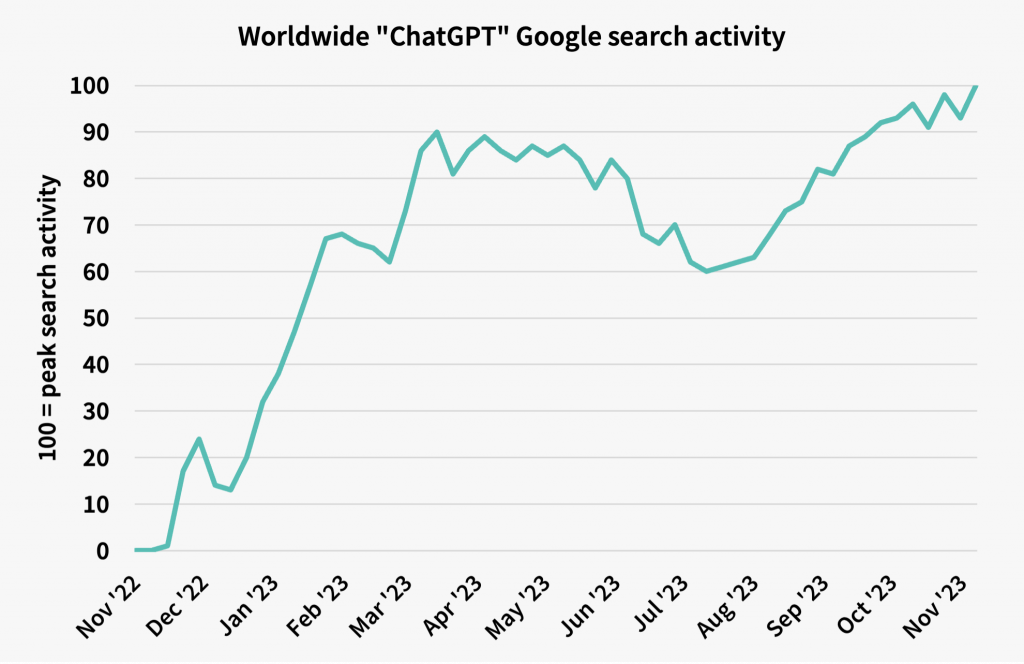On 30 November 2022, the world was introduced to OpenAI’s ChatGPT, a large language model (LLM) AI, initially intended as a “research preview” to seek feedback from the public. What ensued was viral uptake and commentary around the technology, which dwarfed the prior year’s “metaverse” hype. Over the summer, Google Trends data suggested ChatGPT’s peak popularity was already behind it, but this trend reversed as its first birthday approached (Figure 1).

Human and artificial intelligence
AI, the concept of emulating human intelligence, is far from new. Humans have feared superhuman intelligence since prehistory. We developed the curious behaviour of attributing to it unexplained phenomena and currying its favour through prayer and ritual. More recently, the intelligence of machines was famously pondered in Alan Turing’s 1950 paper Computing Machinery and Intelligence. In 2017, DARPA contextualised AI into three overlapping waves: handcrafted knowledge, statistical learning, and contextual adaptation. Each are appraised on their strengths and weaknesses in perceiving, learning, abstracting and reasoning.
In the built environment, Pi Labs has been investing in AI-enabled start-ups since our inception in 2015, but use cases precede this, including the earlier iterations of automated valuation models (AVMs) which can be associated with the aforementioned first and second waves. The development of AI over time has led to voiced concerns around the potential for artificial general intelligence (AGI) and “the singularity” to result in a runaway sentient entity that signifies grave threats to our species. Sceptics accuse such harbingers of misunderstanding the technology, and/or pursuing self-interest by influencing politicians to regulate open source AI out of existence through fear.
Generative AI in the built environment
ChatGPT is categorised as generative AI, a subset of AI which is used to create content on the basis of a corpus of material it has been “trained” on, like artwork or Wikipedia entries. This output content can either be unimodal – entering a text prompt into ChatGPT in order to generate a text response –or multimodal – entering a text prompt into Midjourney in order to generate an image (Figure 2).
Although ChatGPT popularised generative AI, it once again wasn’t the first in this space. Chatbots, for instance, offer a comparable use case to the one initially offered by ChatGPT. In the case of a chatbot, the corpus of data could be a utility company’s internal data, which allows for AI-enabled customer support and decision making. Venture investment colleagues of mine have seen examples of specialised AI-enabled chatbots in the built environment, including property management and insurance use cases. There are also clear use cases for image generation and live rendering in design and marketing. One example of this is Oslo-based Laiout, which generates floor plans and 3D walkthroughs from CAD files according to the user’s inputted needs and regulatory requirements.

The real estate sector’s adoption of AI
Almost as predictable as a hype cycle is the emergence of detractors airing criticisms of its evangelists. In the case of the real estate sector, however, there has been palpable acknowledgement of generative AI’s potential to impact the way we work. During industry interviews on technology deployment, it became evident that the launch of ChatGPT and the ensuing hype had resulted in an unprecedented behavioural shift between real estate practitioners and technology. Ross Hodges from Cushman & Wakefield shared his perception that the rate of adoption of generative AI had been faster than any other technology theme he had come across in commercial real estate. The natural downside of this has been a perverse incentive to rush incomplete products to market, which has been the object of growing criticism.
The hidden value of hype
For real estate innovators and procurement managers, ChatGPT’s first 12 months offers a useful lesson in the hidden value of hype. Although hype can lead to deception, waste and disillusionment, it can also be exploited constructively. In early 2021, my colleague Hugo Silva was completing due diligence on an urban planning start-up that deployed generative design within its product. Its key claim was reducing a weeks-long feasibility process down to a matter of hours. Hugo sought industry feedback at the time, which was largely negative. The concerns amounted to claims that such a tool would add too much complexity to the pre-design stage of a development project.
Hugo’s perception of this disinterest was a gap in industry education on what generative AI is and whether such tools would augment the initial user’s work or render them redundant. In comparison to the level of adoption today, a lot has changed in a short period of time. If a real estate professional had still never laid their hands on a generative AI tool, they at least have access to colleagues with abundantly more knowledge than a year or two prior.
Specialisms and limitations
In June 2023, a Belgian recruitment firm attracted attention for their tongue-in-cheek billboard prompting ChatGPT to “finish this building”. This is a helpful metaphor for the specialised nature of effective AI models. ChatGPT cannot finish a building, just as a wall painting robot cannot summarise a 10,000-word document, just as an AVM trained to appraise New York condominiums cannot appraise an office tower in the City of London. This is due to technologists identifying that attempts to broaden the scope of an AI model tend to result in degradation of its outputs; technology’s version of being unable to be everything to everyone, lest becoming nothing to anyone.
At least for the time being, it appears that AI models are constrained to their expertise, just like their human counterparts. You may therefore find yourself making use of a growing suite of specialised AI-enabled tools, particularly with the growth of AI assistants and plugins tethered to your existing tools and applications.
A special mention to my colleagues at Pi Labs for their work that influenced this article, particularly Phil Cowans, Jimmy Jia, Hugo Silva, Dhruv Gupta, Michelle Wilk, Juliet Kerr and Faisal Butt.







